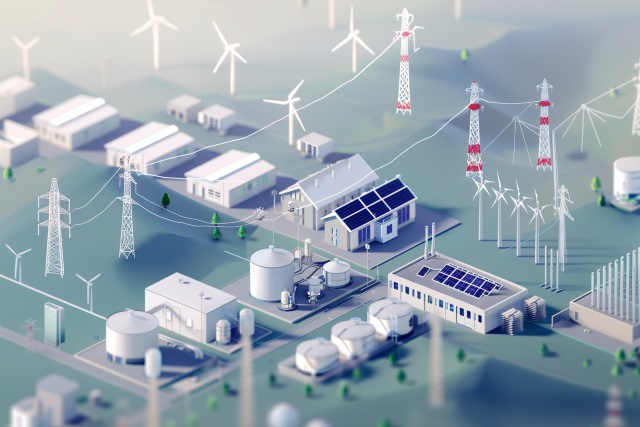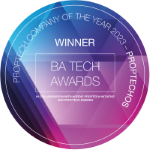The buildings we occupy are living, breathing entities. While not meant literally, how we operate structures in the built environment reflects our day-to-day use.
In commercial real estate (CRE), it is natural that a building’s energy usage will peak during the tenants’ business operating hours. For office space, power consumption will ebb and flow throughout the day; meeting rooms and office floor space will fall in and out of use depending on the customer’s usage.
Energy demand will also fluctuate with the seasons. In the European Union, gas consumption is 2.5 times higher in winter than in summer, with a 30% seasonal swing in electricity demand. HVAC systems need more power to heat buildings during cold European winters, and just 19% of buildings in the EU have air conditioning.
With ESG green buildings transforming the operational efficiency of new builds, and energy management technology more advanced than ever, how can your CRE organization harness the power of flexible energy technology to save on bills across your portfolio? This article will explain how it works in practice.
How smart buildings prioritize flexible energy use
A building’s energy consumption will make up a significant proportion of its owner’s greenhouse gas emissions. They will be responsible for direct on-grid consumption and the energy used by the building’s tenants. Naturally, higher emissions across a portfolio will affect a business’s overall ESG report card.
While it remains the job of governments to transition a country’s energy grid to renewable sources away from fossil fuels, those in the world of property also have a responsibility to use the tools at their disposal to improve energy efficiency within their building portfolios.
Data Collection and Intelligent Control
Technology is on hand to support real estate businesses with this aim for new and retrofitted buildings. ‘Smart buildings’ are designed to minimize operational expense and maximize power-saving efforts by adjusting energy consumption to match daily usage.
Highly advanced sensor-driven technology can be implemented for facilities of all sizes and occupational uses; monitoring the building 24 hours a day and analyzing usage factors such as occupancy, temperature, and sunlight to provide building managers with a real-time picture of energy demand.
An internet-of-things (IoT) system acts as the building’s eyes and ears. The data can be fed into an advanced building automation system (BAS), which can automatically adjust HVAC, lighting, and other key building systems.
Demand Response and User Engagement
These clever technologies can be used in various ways, but maximizing energy efficiency is most commonly achieved with these systems by adjusting energy use based on demand.
Imagine offices that turn off the lights and power down computer systems overnight or when the space is vacant. HVAC systems that cool and heat rooms to match their occupancy. Restorative heat pumps that capture energy used to power the building and convert it into useable electricity.
All of this technology is useable and scaleable for buildings old and new. Some smart buildings also allow occupants to shape their energy usage to their demands. Mobile apps that control lighting to optimize their occupancy allow tenants to contribute to energy savings.
ProptechOS in Action
For Vasakronan, Sweden’s largest real estate owner, meeting their climate neutrality goal and lowering energy consumption across their 168 property portfolio is a top priority.
Working with ProptechOS, Vasakronan were able to connect 16 of their buildings to the sthlmflex energy demand response market, which allows energy providers to buy back unused capacity from consumers.
Without installing any new hardware, ProptechOS were able to develop a predictive model of future energy consumption across Vasakronan’s portfolio. The project allowed Vasakronan to create digital twins of their high energy-consuming equipment (HVAC systems, heating pumps, EV charging stations, etc.), making it easier to implement demand response systems.
Not only did Vasakronan’s power consumption become more efficient, it also resulted in lower energy costs and mitigated Stockholm’s electricity capacity shortage. Its Sergelhusen building in central Stockholm also achieved the world’s third-highest LEED sustainability score.
Decentralized energy sources and virtual power plants
While smart building technology is effective at reducing a building’s power consumption, there is more that can be done to offset the carbon used by tapping into the local grid. State-of-the-art ESG green buildings can be designed with on-site power generation that restores power to the grid while providing energy to the structure’s occupants.
Decentralized Energy Sources (DES)
While on-site power generation is a familiar concept to many, decentralized energy sources (DES) are now being used in increasingly advanced and complex scenarios to support ESG progress within commercial real estate. Examples of DES include:
- Solar panels: Generate electricity from sunlight
- Micro wind turbines: Generate electricity from wind
- Combined heat and power (CHP): Generate both electricity and heat using a single fuel source
- Fuel cells: Produce electricity through an electrochemical reaction.
DES technology allows modern buildings to generate some of their own power, decreasing dependence on the traditional grid and potentially lowering electricity bills. The DES can also add resilience to a building’s energy supply, providing backup power for critical systems.
When it comes to solar regeneration, Spain is a shining example of healthy growth. Its government has committed to ensuring that 90% of the country’s energy supply is solar-generated, with additional measures to ensure all new commercial buildings in the country have solar DES by 2026.
Virtual Power Plants (VPPs)
Virtual power plants (VPPs) are essentially power plants that exist without the physical confines of a traditional power plant. Imagine a network of distributed energy resources like solar panels, batteries, and even adjustable thermostats in homes, all working together to act like a single large power plant.
VPPs connect multiple DES installations, from battery storage systems and renewable energy sources like solar panels and wind turbines to controllable devices in buildings like electric vehicle chargers or smart thermostats. A smart software system monitors and controls all the individual DESs in the network, and can integrate with the wider BMS to further reduce power consumption and adapt to the building’s needs.
VPP technology is gaining traction in the U.S., with new legislation implemented in 2024 to incentivize solar panel and battery technology in residential and commercial buildings. The U.S. Department of Energy aims to increase VPP usage in commercial buildings to 80-60 GW by 2030, saving around $10bn in annual grid costs.
Minimize costs with smart energy management
Energy use is the single largest operating expense of a commercial building. According to the U.S. Environmental Protection Agency, this consumption accounts for a third of a CRE organization’s yearly operating budget and 20% of America’s annual greenhouse gas emissions.
For large portfolio managers, lowering energy bills for each building is a major priority for environmental and economic reasons. Flexible energy and demand response measures are highly effective at reducing this, as they target unnecessary consumption by harnessing data that already exists within a modern BMS.
Harnessing ProptechOS to maximize energy savings
Optimizing energy usage is no easy task, and at ProptechOS, we understand the challenges building managers face within CRE. To capture untapped energy efficiency opportunities, we have created the Energy Efficiency Toolbox — a comprehensive portfolio-level analysis that is scalable for retrofits and new constructions.
Optimize is a major tool in our energy-saving arsenal. It offers portfolio-scale energy and power analytics with hourly data on heating, cooling, and electricity per building. This integrates with your organization’s suite of BMSs, allowing building managers to identify and tweak demand based on peak energy consumption.

Dr. Erik Wallin
Chief Ecosystem Officer, and founder of ProptechOS and RealEstateCore is recognized as a leader in Building Operating Systems (BOS) and making the buildings of the world smarter. He holds an MSc and a Ph.D. in Media and Computer Science from KTH Royal Institute of Technology.
Read his full bio and information here.

